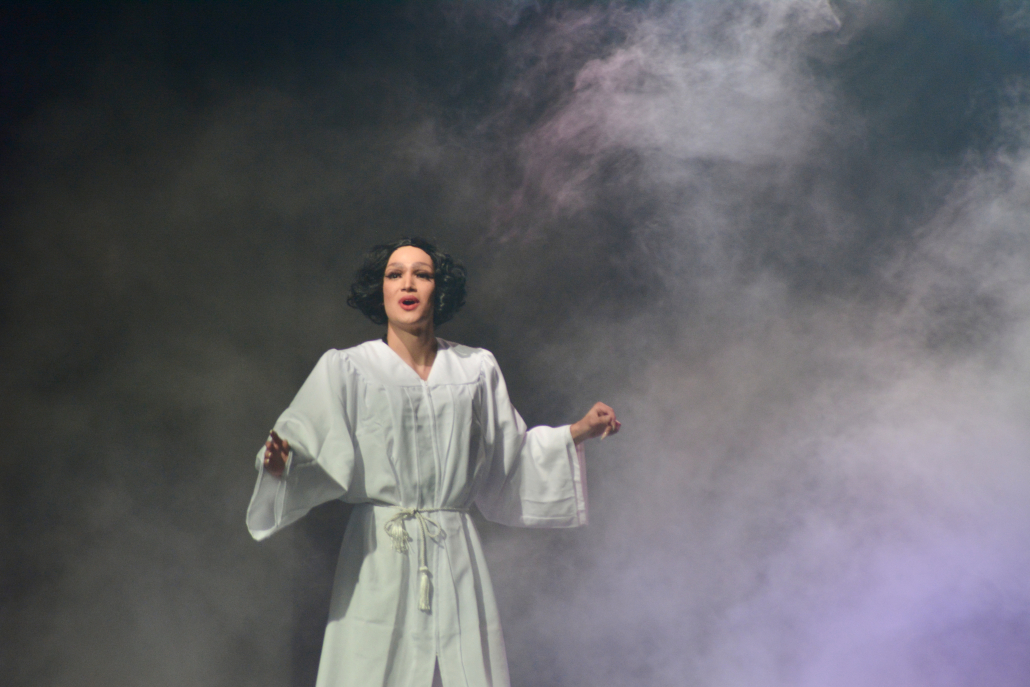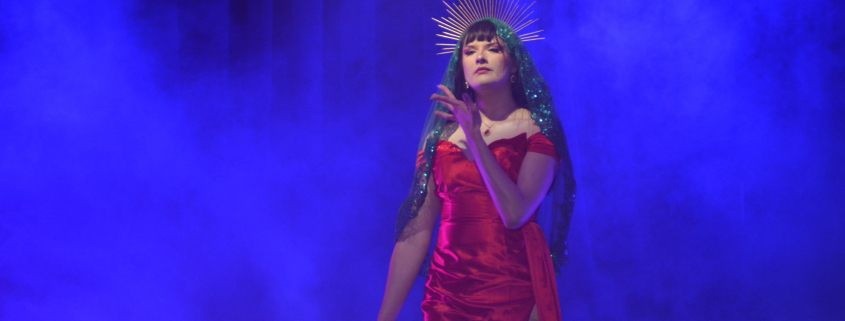QuASA’s drag show takes the stage

Bathed in purple spotlights and blasting Charli XCX, the TCC Ballroom rumbled with excitement Saturday night as USC students, friends and family filed in for an evening of glam and camp at QuASA’s 13th Annual Drag Show: The Universe of Drag.
The fashion show started early with an eclectic group of students in the stands dressed to impress: From T-shirt casual to lacy frocks and dangling chains, the audience was a sample bite of the show’s alluring and diverse three-course extravaganza.
The show was cooked up by executive director Hannah Gardiner, creative and talent director Saneel Sharma and production manager Erin Newsom of the USC Queer and Ally Student Assembly. Gardiner and Sharma also held roles as performers in the show.
A junior majoring in English literature and East Asian languages and cultures by day, Gardiner transformed into Daisy Darling for the evening — a sweet, dollish figure adorned with bows and frills. Sharma, a sophomore majoring in design and marketing, unveiled the stunning looks of Ra Oblivion, a queen of sleek silver and glamor.
Both Gardiner and Sharma performed in last year’s QuASA Drag Show. Pulling from her experience as the former year’s drag intern, Gardiner knew that this year’s event would be the biggest yet with its show stopping effects. Rehearsals started in September to give the performers enough time to prepare their acts and plan the visual effects and sound.
“The stunts are amped up, all the tech is amped up,” Sharma said.

There was also an increase in the number of stunts performed in the show, Gardiner said.
“[The stunts] are, I think, the biggest thing that stands out this year,” she said. “Last year, we had no stunts, which is fine. But this year we have three performers who are explicitly using stunts in their numbers.”
The show opened with a runway showcasing the plethora of drag queens, kings and self-described “drag creatures” in their multitude of outfits. The runway embodied the theme of “Universe of Drag,” illustrating the remarkable variety of drag styles. Lolitas, glamorous queens, rock ‘n’ roll kings and otherworldly creatures of the night flaunted across the stage.
The range in drag styles also reflected the gender and cultural diversity of this year’s drag show.
“This year, we have three cultural, base performers that involve their own heritage,” Sharma said. “We also have a large variety of drag aesthetics, instead of being the typical high femme. We also have performers that just play around with gender both ways. It’s not specific to one side of the spectrum. It’s both. It’s all. It’s everything.”
Performances were split across two acts and many made extensive use of the ballroom’s lighting and technical capabilities. Drag performers embraced all aspects of the medium, especially highlighting their respective comedic, dancing and singing skills.
Scarlet Divinity is the persona of Monica Esquivel, a sophomore majoring in journalism and a queen who embraces her Latine identity through drag. Her standout performance involved her singing live in tribute to the legendary Selena Quintanilla.
“[Selena] is someone that I’ve always looked up to,” Esquivel said. “Being able to perform her on stage and let my own dream live, as well as to pay tribute and in her memory is a great opportunity, I’m really grateful to have been given it.”
In addition to her musical performance, Esquivel emphasized the importance of community in queer spaces.
“The more the merrier. The more inclusive … the [better] outcome that we’re gonna have, because we want to share drag to different facets of the world,” Esquivel said. “Drag is a component that is really important to be able to as a collective, come together and share our lives through art.”

This year’s show was also notable in its number of drag kings and genderfluid performers. Tyra Durden is the bustling Wall Street-inspired drag king persona of Jesse Brindze, a senior majoring in cinema and media studies. Brindze also held an administrative role as the Hair and Makeup Coordinator.
“I was so happy that we have two kings [this year],” Brindze said. “It’s just a lot of diversity in terms of the types of performances as well, like some funny ones, some sexy, some kind of traditional RuPaul-style drag … There was definitely weirdness this year, which I fully support.”
For the first time in the history of the QuASA Annual Drag Show, the night ended with a series of lip sync battles. Audience members voted on which two performers they wanted to see compete. There was also a plethora of audience participation throughout the night as the host, Lorelei, brought crowd members onstage for dance battles and brief interviews.
One of the lip sync battle winners, Willconique, said improv and collaboration in drag is powerful because of its evolving nature. Out of drag, Willconique is Will Yeaman, a freshman majoring in theater.
“There’s a part of drag that isn’t planned. Drag isn’t perfect. It never is. The show never goes perfectly. Tell that to all three nails I lost!” Yeaman said. “There were some boo-boos, but it all came together so beautifully.”

Yeaman emphasized the importance of providing opportunities for queer self-expression and community-building at USC.
“I have an amazing support system with my biological family, but not everyone gets that, so I don’t take that for granted,” Yeaman said. “As queer people, we also get to create a chosen family, and I think that’s really special.”
QuASA hosts a multitude of additional events for the USC queer and ally community, including the Second Chance Prom, a dance in the spring oriented for queer college students that dispels judgment and prejudice, and forefronts acceptance.
Adrian Perez, a sophomore majoring in public policy, said the themes of personal expression was their favorite part of the show.
“The empowering messages throughout … showed that college students can do drag and from a very low price point, and we can all experiment with gender and just be ourselves,” Perez said. “It’s just a beautiful thing.”

